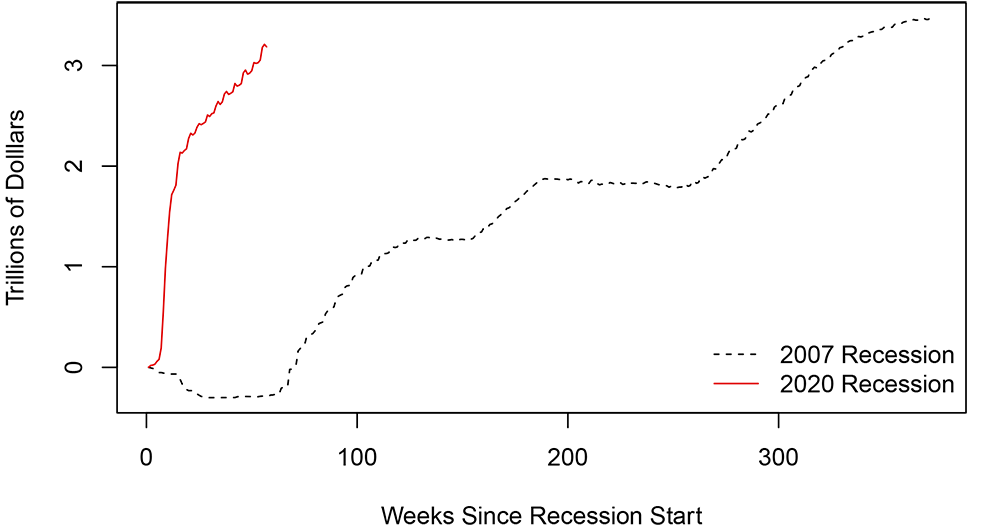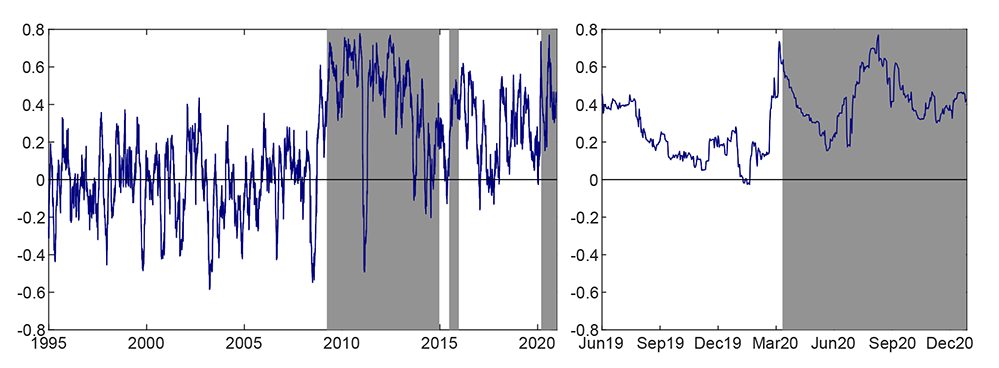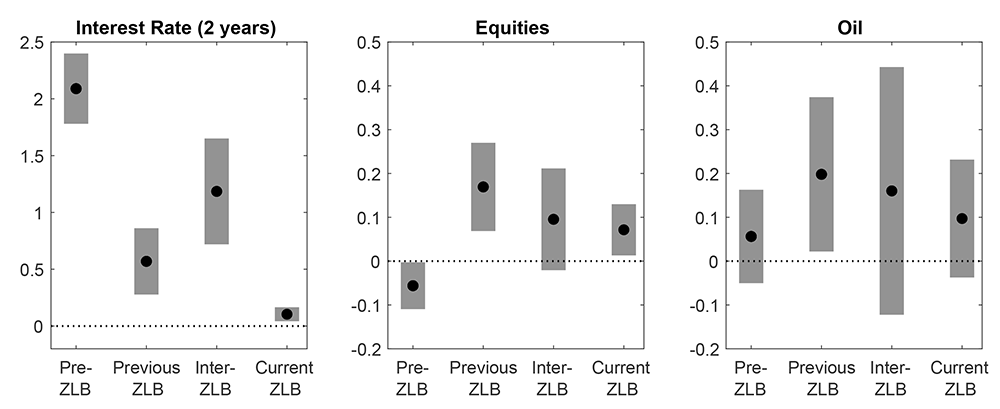
On March 15, 2020, the Federal Reserve lowered the target range for the federal funds rate to 0 to 1/4 percent. With the policy rate at near-zero levels, some commentators have questioned whether the Federal Reserve can take further actions to effectively support the economy. In this note, we analyze the recent behavior of oil and equity prices in the context of our earlier work, Datta, et al. (2021), which focuses on the previous zero lower bound (ZLB) episode, in the aftermath of the Global Financial Crisis. We find that, for the last eight months of 2020, the correlation between oil and equity returns and the responsiveness of these returns to macroeconomic surprises are perhaps elevated relative to normal times but somewhat moderated relative to the previous ZLB episode. This evidence may be consistent with the forceful actions of the Federal Reserve in 2020 resulting in a “nonbinding” ZLB, under which market participants anticipate that the Federal Reserve will respond to economic shocks through the effective use of monetary policy tools other than the setting of the federal funds rate.
When the federal funds rate was at near-zero levels from 2009 to 2015, many economists worried that the ZLB constraint on the federal funds rate would hinder the effectiveness of monetary policy. 2 The concern was that, with the federal funds rate at the ZLB, monetary policymakers would be unable to use their primary tool to respond to additional shocks. In Datta, et al. (2021), we use a theoretical model to demonstrate that, when monetary policy is unable to respond to shocks, the economy becomes more sensitive to those shocks. 3 We also offer empirical evidence based on the changing behavior of oil and equity prices that the economy’s response to shocks changed during the ZLB period from 2009 to 2015. This change suggests that the ZLB constraint was binding in that monetary policy, despite the Federal Reserve’s use of alternative policy tools such as quantitative easing, could not fully respond to shocks.
In addition to lowering the federal funds rate to the ZLB, the Federal Reserve’s early response to the current economic downturn included numerous additional policy actions, including providing forward guidance, offering a variety of liquidity and credit programs, and appreciably and rapidly increasing the size of the Federal Reserve’s balance sheet. 4 Figure 1 highlights just one of these policy actions, comparing cumulative changes in the Federal Reserve’s securities holdings following the start of the most recent recession and the previous recession. In the most recent recession, the pace of purchases has been much faster, with the Federal Reserve increasing its balance sheet by more than two trillion dollars within just a few weeks. If balance sheet and other recent policy actions are considered to be responsive to changes in economic conditions, then they may mitigate the effects of the ZLB. The approach that we used in our earlier work allows us to assess the extent to which asset market sensitivity to shocks has changed in the current ZLB period given the near-zero level of the federal funds rate.
Other researchers, including Debortoli, Galí, and Gambetti (2020) and Wieland (2019), have reported finding insufficient empirical evidence of a change in economic behavior during the previous ZLB episode. However, a key strength of our current and previous work is the use of daily data. Using such high frequency data, we have many observations over a short period, making changes easier to document. In addition, our use of daily data allows us to apply our methodology to the current ZLB episode, even with only eight months of data.

In our previous work, a key piece of evidence of the interaction between monetary policy and the ZLB came from the correlation between oil and equity returns. In an economic model in which the monetary authority follows a simple policy rule, we showed that, when the ZLB causes the actual federal funds rate to differ substantially from the prescriptions of the rule, the oil-equity correlation is higher than in other periods. The mechanism in the model is that, away from the ZLB, if monetary policy follows the Taylor principle, a change in inflation leads to more than a one-for-one change in both the desired and actual nominal rates. By contrast, when the federal funds rate is at the ZLB, a change in inflation still alters the desired nominal rate but if the desired nominal rate is already negative, the actual nominal rate may remain at the ZLB. Consequently, a shock that causes oil prices and inflation to rise will increase real interest rates when the federal funds rate is away from the ZLB but decrease real interest rates when the federal funds rate is at the ZLB. The differing responses of real interest rates induced by the ZLB change the dynamics of equity prices and, as a result, the contemporaneous co-movement of oil and equity returns. Consistent with our model, the oil-equity correlation was elevated throughout the 2009 to 2015 ZLB period when the federal funds rate was near zero. 5
In the current ZLB episode, we find that the oil-equity correlation has been elevated but has not risen as much as in the previous ZLB episode. In figure 2, we show the oil-equity correlation calculated over a three-month rolling window. Since the onset of the COVID-19 pandemic, the oil-equity correlation has been 0.39. In the previous ZLB episode, that correlation was 0.47. Before the Global Financial Crisis, the oil-equity correlation was 0.01, and in the period between the ZLB episodes, it was 0.33. Our conjecture is that the aggressive balance sheet and other policy actions taken by the Federal Reserve in the spring and summer showed that in this ZLB period, monetary policy would continue to be responsive to changing economic conditions. As a result, the effects of the ZLB were dampened, though not eliminated.

In our previous work, we provided additional empirical evidence of the structural change induced by the ZLB by examining how interest rates and oil and equity returns responded to macroeconomic news surprises before and during the previous ZLB period. We defined macroeconomic news surprises as the difference between economic data releases (such as retail sales or industrial production) and the average forecast from a week earlier. Using regression analysis, we documented the changing responsiveness of our dependent variables of interest to these surprises. Table 1 extends this approach through December 2020.
As reported in our paper, we found that the responsiveness of all three dependent variables changed dramatically between the pre-ZLB period and the previous ZLB period, as shown in columns (i) and (ii). In particular, the 2-year interest rate became much less responsive to news surprises, while oil and equities became more responsive. These observations are consistent with our model: Positive news surprises are often inflationary shocks that would induce rising interest rates when the federal funds rate is not at the ZLB. On net, a positive surprise and rising real interest rate would be offsetting, leading oil and equity returns to have very little sensitivity to the news surprise. By contrast, when the federal funds rate is near zero, an expansionary surprise would be associated with falling real rates and a positive response by both oil and equity prices.
| Pre-ZLB (i) | Previous ZLB (ii) | Inter-ZLB (iii) | Current ZLB (iv) | ||
|---|---|---|---|---|---|
| Interest rate (2 years) | $$\beta$$ | 2.09 | 0.57 | 1.19 | 0.10 |
| t-stat | 13.3 | 3.9 | 5.0 | 3.2 | |
| Equities | $$\beta$$ | -0.06 | 0.17 | 0.10 | 0.07 |
| t-stat | -2.1 | 3.3 | 1.6 | 2.4 | |
| Oil | $$\beta$$ | 0.06 | 0.20 | 0.16 | 0.10 |
| t-stat | 1.0 | 2.2 | 1.1 | 1.4 | |
| Observations | 2338 | 763 | 460 | 77 |
Note: The table reports the value of $$\beta$$ from the regression using pooled surprises, $$Y_t = \alpha + \beta S_t + \varepsilon_t$$, where $$S_t$$ is the average of standardized news on day t. The value of $$\beta$$ measures the response of each dependent variable to a one standard deviation news surprise. The pre-ZLB period covers January 1990 to March 2009. The previous ZLB period covers April 2009 to December 2014 and July 2015 to December 2015, the periods during which the Taylor-rule implied notional rate is negative. The inter-ZLB period covers January 2016 through February 2020. The current ZLB period covers May 2020 through the end of our sample in December 2020.

Turning to our results using data through December 2020 for the current ZLB period, (column iv) we make three observations. First, as during the previous ZLB period, the two-year interest rate was less responsive than it was during the pre-ZLB period. If short-term interest rates were highly responsive to macroeconomic news, we might conjecture that market participants believed that the period of economic weakness would be shallow or brief. However, the evidence suggests that the two-year interest rate was unresponsive to news through December 2020. As such, market prices indicated that short-term interest rates were constrained by the ZLB and the Federal Reserve was not expected to offset shocks through changing the federal funds rate in the short term.
Second, the estimated responses of oil and equity returns to macroeconomic news surprises in the current ZLB episode were elevated relative to the pre-ZLB period, but are not as large as in the previous ZLB episode. This moderately elevated responsiveness to surprises suggests that, even though interest rates were constrained, monetary policy was considered to be somewhat responsive to changes in economic conditions.
Third, for oil and equities, the average response to surprises during the current ZLB period is based on relatively few macroeconomic data releases. Though we have excluded the most acute COVID crisis period by dropping March and April 2020 from the data set, extreme news announcements have occurred much more frequently in the current ZLB period than in the past and could be important influencers of the regression results.
To conclude, the current correlation between oil and equities suggests that market participants see monetary policy as somewhat constrained by the ZLB but perhaps better able to respond to economic conditions than in the previous ZLB period. That said, these preliminary conclusions rely on relatively little data, and we will learn more as the current ZLB episode evolves.
Action Economics, LLC (1980–2021). “Action Economics Weekly Survey, Historical Indicator and Survey Data” (accessed February 12, 2021).
Board of Governors of the Federal Reserve System (US) (2021a). “2-Year Treasury Constant Maturity Rate [DGS2].” Retrieved from FRED, Federal Reserve Bank of St. Louis (accessed February 12, 2021).
Board of Governors of the Federal Reserve System (US) (2021b). “Assets: Securities Held Outright: Securities Held Outright: Wednesday Level [WSHOSHO].” Retrieved from FRED, Federal Reserve Bank of St. Louis (accessed February 12, 2021).
Christiano, Lawrence, Martin Eichenbaum, and Sergio Rebelo (2011). “When Is the Government Spending Multiplier Large?” Journal of Political Economy, vol. 119 (1), pp. 78–121.
Datta, Deepa D., Benjamin K. Johannsen, Hannah Kwon, and Robert J. Vigfusson (2021). “Oil, Equities, and the Zero Lower Bound” American Economic Journal: Macroeconomics, vol. 13 (2), pp. 214–53
Debortoli, Davide, Jordi Galí, and Luca Gambetti (2020). “On the Empirical (Ir)relevance of the Zero Lower Bound Constraint,” in Martin Eichenbaum, Erik Hurst, and Jonathan A. Parker, eds., NBER Macroeconomics Annual 2019, vol. 34. Chicago: University of Chicago Press, pp. 141–70.
Eggertsson, Gauti B. (2011). “What Fiscal Policy is Effective at Zero Interest Rates?” in Daron Acemoglu and Michael Woodford, eds., NBER Macroeconomics Annual 2010, vol. 25. Chicago: University of Chicago Press, pp. 59–112.
French, Kenneth R. (2021). “Data Library.” (accessed February 12, 2021).
Ihrig, Jane, Gretchen C. Weinbach, and Scott A. Wolla (2020). “COVID-19’s Effects on the Economy and the Fed’s Response.” Federal Reserve Bank of St. Louis, Page One Economics, September.
National Bureau of Economic Research (2021). “US Business Cycle Expansions and Contractions.” (accessed February 12, 2021).
U.S. Energy Information Administration (2021). “Petroleum & Other Liquids, Data, NYMEX Futures Prices.” (accessed February 12, 2021).
Wieland, Johannes (2020). “Are Negative Supply Shocks Expansionary at the Zero Lower Bound? Inflation Expectations and Financial Frictions in Sticky-Price Models.” Journal of Political Economy, vol. 127 (3), pp. 973–1007.
Woodford, Michael (2011). “Simple Analytics of the Government Expenditure Multiplier.” American Economic Journal: Macroeconomics, vol. 3 (1), pp. 1–35.
1. The views expressed in this paper are solely those of the authors and should not be interpreted as reflecting the views of the Board of Governors or the staff of the Federal Reserve System. The authors would like to thank Joshua Hu and Nicholas Zevanove for excellent research assistance. Return to text
2. Representative papers on this issue include Eggertsson (2011), Woodford (2011), and Christiano, Eichenbaum, and Rebelo (2011). Return to text
3. The paper “Oil, Equities, and the Zero Lower Bound” by Deepa D. Datta, Benjamin Johannsen, Hannah Kwon, and Robert Vigfusson, was recently published in the American Economic Journal: Macroeconomics: https://t.co/XjTL8v9xmB?amp=1. The working paper version is here: https://www.federalreserve.gov/econres/feds/files/2018058pap.pdf. Return to text
4. For a discussion of COVID-19’s effects on the economy and the Federal Reserve’s response, see Ihrig, et al. (2020). Return to text
5. The correlation did briefly turn negative in early 2011 when oil and equity prices were buffeted by the Arab Spring, but this was a short-lived exception. Return to text
Please cite this note as:Datta, Deepa D., Benjamin K. Johannsen, Robert J. Vigfusson (2021). "Oil, Equities, and a “Nonbinding” ZLB: The Monetary Policy Response to COVID-19," FEDS Notes. Washington: Board of Governors of the Federal Reserve System, April 14, 2021, https://doi.org/10.17016/2380-7172.2786.
Disclaimer: FEDS Notes are articles in which Board staff offer their own views and present analysis on a range of topics in economics and finance. These articles are shorter and less technically oriented than FEDS Working Papers and IFDP papers.